第二语言习得入门PPT-Unit 2
外汉概论 之四 第四讲 第二语言习得理论概述PPT教学课件
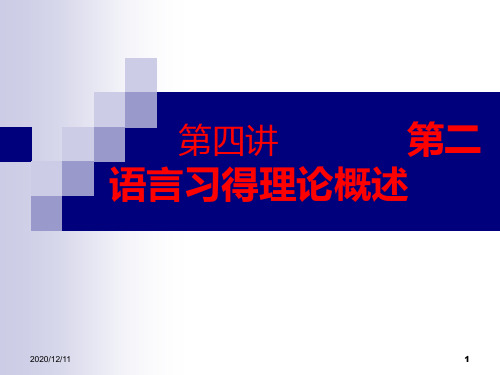
第二
语言习得理论概述
2020/12/11
1
第一节 对比分析
第二节 偏误分析
第三节 中介语及其变异
第四节 二语习得的自然发展途径
第五节 输入与互动
第六节 学习者个体差异
第七节 学习者的策略
第八节 语言普遍性假说
2020/12/11
2
第一节 对比分析
1. 行为主义学习理论
2. 对比分析的内容
3. 对比分析遭遇的批评
2020/12/11
14
对比分析与语言学
对比分析的语言学基础是结构主义语 言学。
它强调对一种语言进行细致描述。 描述的基础是组成句式的不同范畴。 范畴由形式项定义,由归纳法建立。 在对比分析中,语言差异受到强调。
2020/12/11
15
多数对比研究基于语言表层的结构特征。对比 程序如下:
假说有两派:强硬派和温和派。
强硬派宣称:第二语言中所有偏误都可以通过 认定目的语和学生第一语言的区别来预测。
温和派认为,并非所有偏误都源于干扰。对比 分析需要跟偏误分析共同进行。首先,真实的 偏误必须通过分析学习者的语言来认定。其次, 对比分析可以用于证实哪些偏误是由一语和二 语的区别引发的。
2020/12/11
6
习惯如何形成的,有多种解释:
Watson的古典行为主义认为,刺激诱发 (elicit)反应。刺激的发生达到足量的频率, 反应就形成惯例并转化为无意识行为。
Skinner的中期行为主义理论认为,反应比刺 激重要。反应发生后,若有一个特定行为强化 它,就可能促进习惯的形成。学习一种习惯, 可以通过模仿(imitation)或强化(reinforcement) (根据学习者反应的适当与否给以奖励或惩罚, 直到只发生适当反应为止)。
二语习得入门英语课件
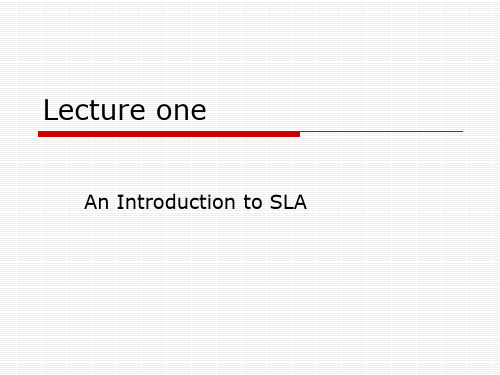
Performance consists of the use of this grammar in the comprehension and production of language.
Communicative competence includes knowledge the speakerhearer has of what is effective as well as correct language behavior and also of what constitutes effective language behavior in relation to particular communicative goals. It includes both linguistic and pragmatic knowledge.
Communicative performance
Consists of the actual use of these two types of knowledge in understanding and producing discourse
The main goal of SLA research is to characterize learners’ underlying knowledge of the L2, to describe and explain their competence. However, learner’s mental knowledge is not open to direct inspection. It can only be inferred by examining samples of their performance.
二语习得SecondLanguageAcquisitionPPT课件

1. What is Second Language Acquisition and Research? 2. Theories of L2 learning
Linguistic Perspectives Psychological Perspectives (behaviorism, cognitive psychology, connectionism, multidimensional model) Interactionist Perspective Sociocultural Perspectives
is a difference between the way language is acquired and
processed and the way other kinds of information are
acquired and processed.
74
Second Language Acquisition
75
Second Language Acquisition
1. The Grammar-Translation Method (structuralism) 2. The Audio-Lingual Method (听说法) (structuralism, behaviorism s-r) 3. Communicative Language Teaching (交际法语言教学) (cognitive science, linguistic competent, communicative competent) 4. Content-based, Task-based Approaches (学科性方法)
二语习得(L2)
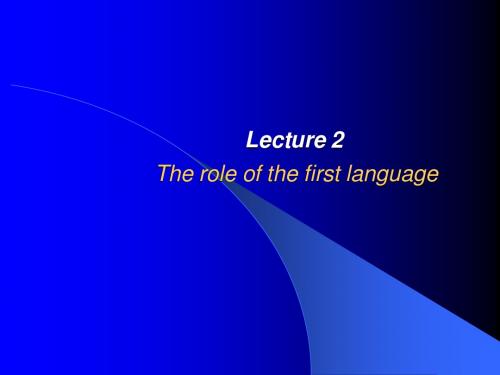
Theories of habit formation were theories of learning in general. They could be and were applied to language learning.(L1 acquisition →imitating utterances, SLA could process in a similar way). Imitation and reinforcement were the means by which the learner identified the stimulus-response associations that constituted the habits of the L2. Habit-formation theory dominated discussion of both first and second language acquisition up to the 1960’s for it provides a theoretical account of how the learner’s L1 intruded into the process of SLA.
Introduction
Some popular believes Second language acquisition (SLA) is strongly influenced by the learner’s first language(L1). The role of L1 in SLA is a negative one. That is, the L1 gets in the way or interferes with the learning of the L2, such that features of the L1 are transferred into the L2.
第二语言习得PPT
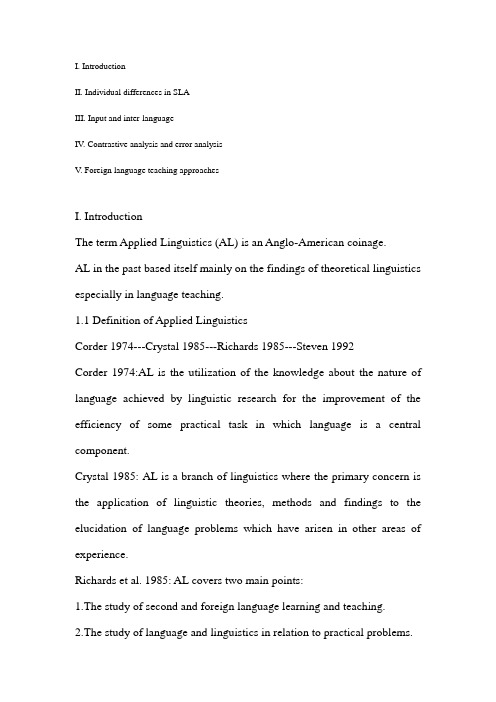
I. IntroductionII. Individual differences in SLAIII. Input and inter-languageIV. Contrastive analysis and error analysisV. Foreign language teaching approachesI. IntroductionThe term Applied Linguistics (AL) is an Anglo-American coinage.AL in the past based itself mainly on the findings of theoretical linguistics especially in language teaching.1.1 Definition of Applied LinguisticsCorder 1974---Crystal 1985---Richards 1985---Steven 1992Corder 1974:AL is the utilization of the knowledge about the nature of language achieved by linguistic research for the improvement of the efficiency of some practical task in which language is a central component.Crystal 1985: AL is a branch of linguistics where the primary concern is the application of linguistic theories, methods and findings to the elucidation of language problems which have arisen in other areas of experience.Richards et al. 1985: AL covers two main points:1.The study of second and foreign language learning and teaching.2.The study of language and linguistics in relation to practical problems.Steven 1992:AL is a multidisciplinary approach to the solution of language-related problems.The problems it attempts to solve include speech pathology, machine translation, national language planning policy, various facets of communication research and many others.HU Zhuang Lin 2004:Applied Linguistics (AL) serves as a mediating area which interprets the results of linguistic theories and makes them user friendly to the language teacher and learner.1.2 EFL and ESL(EFL) ENGLISH AS A FOREIGN LANGUAGE : Learning English in a community that doesn’t speak English.(ESL) ENGLISH AS A SECOND LANGUAGE: Leaning English in a place where it is the spoken language.According to UNESCO, second language is a language acquired/learned by a person in addition to his mother tongue.1.3 Learning and AcquisitionLearning is a deliberate, conscious attempt to master a language, while acquisition is a less deliberate, subconscious process of mastering language.As a L2 learner, you can hardly speak in the same way as a native speaker. Phonologically, morphologically, syntactically, semanticallyand pragmatically, there bound to be some differences.1.4 First and Second Language AcquisitionThink about a baby acquiring his first language.Think about a person acquiring a second language.What similarities and differences are there in the two processes? Second language learning :painstaking unsuccessfulFirst language acquisition: unconscious successfulFeature 1: Commandchildren normally achieve perfect L1 masteryadult L2 learners are unlikely to achieve perfect L2 mastery Feature 2: Successsuccess guaranteed complete success rareFeature 3: Intuitionschildren develop clear intuitions about correctnessL2 learners are often unable to form clear grammaticality judgments (The house is easy to catch fire.)Feature 4: Negative evidencecorrection not found and not necessarycorrection generally helpful or necessaryFeature 5: GoalsTarget language competenceL2 learners are more concerned with fluency than accuracy, as targetlanguage competence is too difficult to achieve.II. Individual differences in SLAIndividual differences: Age, Personality traits, Cognitive style, Learning strategies, Motivation, Language aptitude2.1 Age and Second Language AcquisitionIs it better to learn a second language when one is young or when one is older? Why?Lenneberg (1967) stated that L2 is best learned between age 2 and puberty.Case studyDo we actually find such a critical period for L2 acquisition?What would a critical period for L2 acquisition look like?Do late learners ever attain nativelikeness?Critical period for L2 acquisitionGeometric features”Heightened sensitivity at beginningClear point where offset (decline) beginsFlat period when critical period is overTemporal features”Heightened sensitivity through early childhoodSensitivity bottoms out when full neurocognitive maturity is reached Continued low sensitivity throughout adulthoodTentative conclusionsIs there a sharp cutoff point where sensitivity begins to decline? NO Does sensitivity flatten out in adulthood? NOIs there a significant change in sensitivity when maturation is reached? NOAdvantages to being a younger learnerMore likely to develop a native-like accentLess to learn to be considered proficientMore likely to receive comprehensible inputAdvantages to being an older learnerCan consciously use strategies to aid learningHas knowledge from L1 to draw fromHas greater control over inputGrammatical CompetenceMastery of language code: Lexicon (vocabulary), Word formation rules, Sentence formation rules, Pronunciation rules, Spelling rules Sociolinguistic CompetenceMastery of appropriate language use in different contextsHow to speak to a friendHow to speak to someone in authorityHow to speak socially vs. ProfessionallyDiscourse CompetenceMastery of how to combine meanings and forms to create a text in different modesExamples: Telephone inquiry ,Narrative text, Oral reportStrategic CompetenceMastery of verbal and non-verbal strategies to compensate for breakdowns in communicationExamples: How to ask for help How to rephrase a statement2.2 MotivationThere isn’t much theory that “provides an all-round explanation of what we do and why.”(Dörnyei 2003:1)“Motivation is a multifaceted construct, and the exact nature of the constituent components activated in a particular situation depends greatly on contextual factors.”(Dörnyei 2003:1) Instrumental motivation--- Immediate achievement Go abroad Social responsibility Individual development----Instrumental motivationCultural motivation---Intrinsic interest Go abroad Social responsibility Information medium---Integrative motivation Interest motivationSituational motivation---Learning situation---Situational motivation Metacognitive strategiesA. Centering your learningB. Arranging and planning your learningC. Evaluating your learningAffective strategiesA. Lowering your anxietyB. Encouraging yourselfC. Taking your emotional temperatureSocial strategiesA. Asking questionsB. Cooperating with othersC. Empathizing with othersResearch has demonstrated(1) Learners are actively involved in their learning.(2) Learners use different kinds of strategies(3) Learners have different beliefs about strategy use and learning approaches(3) Several factors have powerful influence on strategy choice/use: motivation, proficiency, years of study,sex, major, if requirementThe good language learner:(1) is guesser, but an accurate guesser!(2) has a strong drive to communicate.(3) is not often inhibited (a risk-taker).(4) focuses on communication, but also attends to form.(5) practices—and creates opportunities to do so.(6) knows what is appropriate.(7) monitors his own and the speech of others.(8) attends to meaning.(9) Actively participates (aloud and silently).III. Input and Inter-language3.1 Input theory by Krashen Interaction theory by Long Output theory by Swain3.2 InterlanguageDefinition of inputQuestion:Could you explain “input”in second language acquisition?Learners' most direct source of information about the target language is the target language itself. When they come into direct contact with the target language, this is referred to as "input." (/wiki)Stephen Krashen (University of Southern California) is an expert in the field of linguistics, specializing in theories of language acquisition and development. Much of his recent research has involved the study of non-English and bilingual language acquisition. During the past 20 years, he has published well over 100 books andarticles and has been invited to deliver over 300 lectures at universities throughout the United States and Canada.3.1 Krashen’s Input HypothesisKrashen's theory of second language acquisition consists of five main hypotheses:1) the Acquisition-Learning hypothesis,2) the Monitor hypothesis,3) the Natural Order hypothesis,4) the Input hypothesis,5) the Affective Filter hypothesis.Input Hypothesis"The best methods are therefore those that supply 'comprehensible input' in low anxiety situations, containing messages that students really want to hear. These methods do not force early production in the second language, but allow students to produce when they are 'ready', recognizing that improvement comes from supplying communicative and comprehensible input, and not from forcing and correcting production."The Input hypothesis is Krashen's attempt to explain how the learner acquires a second language.This hypothesis claims that “humans acquire language in only one way-by understanding messages or by receiving ‘comprehensibleinput’”(Krashen, 1985:2)Comprehensible input: i+1; output plays little role.Comment on Input theoryInfluential: application in SLT, Types of input, Ways of input, Variety of input, Sufficiency of input, Efficiency of input Controversial:How to quantify and qualify the “i”and “1”in “i+1”Ignorance of outputViews diverge greatly as to what kind of input should be provided for language learners.Authentic input, Comprehensible input (Krashen): i+1 Premodified input, Interactively modified inputInput-based teachingDirect method, Natural approach, Total physical response, Communicative approach, Community language learning (CLL) , Suggestopedia, Silent wayLong’s Interaction HypothesisLong's interaction hypothesis proposes that language acquisition is strongly facilitated by the use of the target language in interaction. In particular, the negotiation of meaning has been shown to contribute greatly to the acquisition of vocabulary (Long, 1990).Study: NSs-NNSs, negotiation for meaning---comprehensible inputThe Interaction Hypothesis highlights the role of social interaction in increasing the amount of comprehensible input that students receive. This interaction includes students asking for help when they do not understand input. Perhaps, the collaborative setting in groups and the trust that can grow among groupmates make it more likely that students will have opportunities to repair comprehension breakdowns.Swain’s Output HypothesisMerrill Swain(Ph.D., University of California)She is Professor in the Curriculum, Teaching and Learning department at the Ontario Institute for Studies in Education (OISE) at the University of Toronto. website: http://www.oise.utoronto.ca/mlc/swain.htmThe output hypothesis claims that the act of producing language (speaking or writing) constitutes, under certain circumstances, part of the process of second language learning.It states that while comprehensible input is necessary for L2 learning, learners also need to speak and to write, i. e., produce output, in their L2.Three functions of output in second language learning:1) the noticing/triggering function 发现所想与所能之间的差别2) the hypothesis-testing function 测试语言假设3) the metalinguistic (reflective) function.增加元语言知识没有输出需要的输入不易转化为程序性知识没有输入帮助的输出不利于语言体系的拓展输出-输入结合的教学活动更具有交际的真实性(文秋芳,2008)3.2 InterlanguageThe type of language constructed by second or foreign language learners who are still in the process of learning a language is often referred to as interlanguage.It is often understood as a language system between the target language and the learner’s native language.E.g. data from SWECCLInterlanguage is a dynamic language system, which is constantly moving from the departure level to the native-like level.Can be done in two ways:investigating the psychological, biological or neurological mechanisms involved in the production of interlanguage; investigating the linguistic features of interlanguage.Concerning the linguistic features of interlanguage, the following questions can be asked:Linguistically, how is interlanguage in general different from the target language or the native language?In what way is lower level interlanguage different from higher levelinterlanguage?How is the interlanguage system used to convey meaning?IV. Contrastive Analysis and Error AnalysisWe assume that the student who comes into contact with a foreign language will find some features of it quite easy and others extremely difficult. Those elements that are similar to his native language will be simple for him, and those elements that are different will be difficult. Lado, 1957, 24.1 Contrastive Analysis (1940s ---1960s)Paul Nation is Professor in Applied Linguistics at the School of Linguistics and Applied Language Studies (LALS) at Victoria University of Wellington, New Zealand.“Research shows that the first language has a small but important role to play in communicating meaning and content.”(Paul Nation, in his article, The Role of the First Language in Foreign Language)4.1.1 Definition of Contrastive Analysis (CA)A way of comparing L1 and L2 to determine potential errors for the ultimate purpose of isolating what needs to be learned and what not in a second language learning situation. (Gass & Selinker, 2001:72) An approach to the study of SLA which involves predicting and explaining learner problems based on a comparison of L1 and L2 todetermine similarities and differences”(Saville-Troike, 2006: 34) 4.1.2 Objectives of CAProviding insights into similarities and differences between languages;Explaining and predicting problems in L2 leaningDeveloping course materials for language teaching4.1.3 Contrastive Analysis HypothesisMain assumptions1) L2 learning involves overcoming difficulties in the linguistic systems of the target language;2) The main difficulties in learning a L2 are caused by interference from the L1;3) Contrastive analysis can predict, or at least account for, difficulties in L2 learning, so teaching materials based on contrastive analysis can reduce the effects of interference and difficulties, and facilitate L2 learning.Contrastive Analysis Hypothesis"Where two languages were similar, positive transfer would occur; where they were different, negative transfer, or interference, would result." (Larsen-Freeman & Long 1991: 53)3 versions of the CA hypothesisThe Strong Version: Fries & LadoIt (a priori) claimed that prediction of difficulties in learning L2 could be made based upon a comparison of two languages. This starts with a crosslinguistic analysis and then attempts to predict trouble spots.The Weak Version: Wardhaugh (1970)It (a posteriori) claimed that cross-linguistic comparison could help to explain learner errors. This starts with learner errors and attempts to account for them with cross-grammatical comparisons.The Moderate Version: Oller & ZiahosseinyIt differs from the above two in that it emphasizes the significance of minimal distinctions, which may actually cause the greatest interferences and difficulties.4.1.4 Procedures of CA2 principles of CA as proposed by Halliday:Describe before comparingComparing patterns, not whole languagesSteps:The separate description of the relevant features of each language; The establishment of comparability;The comparison and contrast.4.1.5 Evaluation of CAHA. Application, Prediction & Diagnosis of errorsTesting, Course design, Selection, Grading,Contrastive teaching B. Problems with contrastive analysisProblem #1The predictions made by proponents of the CAH were often inaccurate, or even false.There was underprediction (i.e. the CAH failed to predict some errors).There was overprediction (i.e. the CAH predicted errors that did not materialize).French object pronouns precede the verb: Je les vois "I them see." English L1 learners of French will say:*"Le chien a mange les" instead of "Le chien les a mange*"Il veute les encore" instead of "Il les veut encore"" (Ervin-Tripp, 1974)But, French L1 learners of English do not say"I them see." (Je les vois) instead of "I see them"Why does it work one way but not the other?Problem #2It is not true that similarity always equals ease of learning and difference always equals difficulty; (sometimes it’s the other way round)Problem #3L1 transfer is effected by other factors, e.g. the amount and type of TL exposure learners receive.Problem #4Many studies have shown SLLs from very different L1 backgrounds make similar errors.This suggests that many of the most common learner errors are not due to interference of native language.See Ortega, 2009. Section 3.1 p. 310nly about 30% of errors have been attributed to L1. This ranges from 3% for child Spanish learners of English (Dulay & Burt, 1973) to 50% for adult Chinese ESL (Tran Chi Chau 1975)ConclusionWhile interference plays a role in SLA, so do many other factors and thus the role of the first language is less than what was thought by proponents of CA.4.2 Error AnalysisEA refers to the study and analysis of the errors made by second and foreign language learners.Purposes of EA:1) identify strategies which learners use in language learning;2) identify the causes of learner errors;3) obtain information on common difficulties in language learning,as an aid to teaching or in the preparation of teaching materials.4.2.1 Error and mistakeError: Systematic deviation by learners who have not yet mastered the rules. More difficult to correct. Indication of learner’s attempt to figure out the L2 systemMistake: Random performance slip caused by fatigue, excitement, etc. Readily self-corrected.4.2.2 Types of errorsStructural errors (breaking of a rule)e.g. (1) The fast economic growth causes people’s living condition has improved.(2) The job is fit me very well.(3) 报有希望carry the hope; entertain the hope(4) 找借口look for an excuse; make an excuse(5) rather proud, good, young, fresh, practicalquite annoyed, nervous, wrong, serious, limited, difficult, common Non-structural errors,deviations from some kind of norm ('breaches of code') quantitative differences (overuse, underuse)E.g. No smoking, please.Overuse of “make”, “happy”, “glad”.Underuse synonyms of “happy”such as cheerful, light-hearted,delighted etc.Interlingual errors (transfer errors): misuse of an item because of L1 influence. based on cross-linguistic comparisonsIntralingual errors (developmental errors): within L2 (e.g. overgeneralization) based on language being learned4.2.3 Procedure of error analysis1. Collection of samples of learner language2. Identification of errors3. Description of errors4. Explanation of errors (Ellis 1994)4.2.4 Problems with Error Analysis1) Focus on errors mean that researchers ignored what the learner did right.2) Empirically it was difficult to identify the source of many errors.3) It doesn't account for all the problems that learners have, e.g. Avoidance. Learner avoids a certain word or structure.V. Foreign Language Teaching MethodologyDiscussion:What teaching method do you know in ELT?On which theory is it founded?A Retrospective of Foreign Language Teaching Methodology Traditional gramma: Classical language teaching (before 1880)Grammar- Translation MethodStructuralism: Beginning of Modern Language Teaching (from 1880 to the 1st world war): Direct methodMentalism: Development of Modern Language Teaching (from the 1st World War to ’70) : Cognative MethodFunctionalism: Intensification of Modern Language Teaching (after ’70): Communicative MethodConstructivism: Improvement of Modern Language Teaching( after 1980’s) : Constructivist MethodPost-modernism : Perfection of Modern Language Teaching(after1990’s): Post-method1) Traditional grammar---Grammar-Translation Method Correctness, literary excellence, the use of Latin models, the priority of the written languageTextbook takes prominent writers as language models.Teaching involves the presentation of numerous definition, rules and explanations.2) Structuralist linguistics---Direct methodThe spoken language in people’s communication.The focus on the grammatical structures of a language.A pattern drill technique aiming at the learner’s automatisms for language forms.3)Mentalism/Transformational-GenerativeLinguistics---Audio-lingual Method把语言看成一个内在的规则系统( a system of innate rule),认为语言学习者有一种普遍的语言知识(linguistic competence)。
二语习得ppt课件

教师语言:对外汉语教学课堂 例:请大家打开书。 书Book,打开Open
8
第二语言习得发展的重要影响
1、母语者与第二语言学习者交流使用的话语具有的“外国 人话语”“教师语言”特点,这种特定的语域风格的话语 为第二语言学习者提供了一个可理解输入环境。
2、母语者与第二语言学习者的交流除了话语形式的调整, 还有话语结构和功能的调整。这种互动环境对第二语言学 习者的语言习得过程也会产生重要的影响。
Hatch and Wagner-Gough,1976 Hatch ,1978a Peck,1978
早期关注是学习者的语言产出 语言输入与互动
5
研究材料来自母语者与学习者交流的转写材料,这些 材料使研究者不仅能观察到学习者的语言产出过程, 即学习者是怎么说的,同时也可以观察到母语者为学 习者提供语言输入的过程,即母语者对学习者是怎样 说的。
6
一、语言输入与互动的含义
• 两种不同的语言输入环境 语言输入:为学习者提供的单向的语言信息。 例:听广播、看电视等。 学习者没有交流和沟通的机会。
互动:双向的语言沟通和交流。 例:母语者或教师与学习者之间的交流和沟通, 学习者之间的交流和沟通。 构成了语言习得发生的互动环境。
7
• 显示出一种特定的语域风格 保姆语言(儿语、母亲语言):母亲对学说话的儿童 外国人话语:母语者与第二语言学习者
9
二、 三种不同的语言 输入观
10
狼孩
“狼孩”刚被发现时,生活习性与狼一样; 不会讲话,每到午夜后像狼似地引颈长嚎。
11
卡玛拉经过7年的教育,才掌握4、5个词,勉强地学 几句话,开始朝人的生活习性迈进。她死时估计已 有16岁左右,但其智力只相当3、4岁的孩子
第二语言习得理论PPT课件

语言能力是关于语言的知识; 语言表达是关于语言运用的知识。
.
8
第二节 第二语言习得研究的学科性质
一 第二语言习得研究与语言学 1 研究对象不同 2 目的不同 3 方法不同
.
9
第二节 第二语言习得研究的学科性质
二、第二语言习得研究与心理学 1 研究目的不同 2 研究范0
.
3
二 第一语言和第二语言
第一语言是指儿童幼年最先接触和习得的 语言。
第二语言是相对于学习者习得的第一语言 之外的任何一种其他语言而言的。
第二语言强调语言习得的先后顺序,与语 言习得的环境无关。
.
4
三 习得与学习
习得(acquisition)指非正式的语言获得 (informal learning),儿童大多是通过这 种方式来获得母语的。(下意识,隐性知 识)
有指导的第二语言习得是以教学指导的方 式获得第二语言,语言习得通常是在课堂 教学环境中发生的。
.
7
六 语言能力与语言表达
语言能力(competence)是由交际双方内在语 法规则的心理表征构成的。语言能力是一种反应 交际双方语言知识的心理语法。
(隐性语言知识-对句子合法性的直觉判断)
语言表达(performance)是交际双方在语言的 理解与生成过程过程中对其内在语法的运用。
外语习得指学习者所学的语言在本国不是作为整 个社团的交际工具,而学习者所学的语言主要是 在课堂学习的。
第二语言习得与外语习得是指两种不同的语言环 境而言的。
.
6
五 自然地第二语言习得与有指导的 第二语言习得
自然的第二语言习得是指以交际的方式获 得第二语言,而且语言习得通常是在自然 的社会环境下发生的。
二语习得理论ppt课件
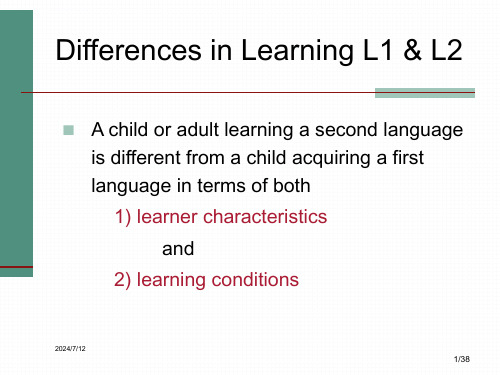
2024/7/12
7/38
在整堂课的教学中,刘教师总是让学 生带着 问题来 学习, 而问题 的设置 具有一 定的梯 度,由 浅入深 ,所提 出的问 题也很 明确
Negative Transfer
Lado proclaimed that most of the difficulties originated from the differences between L1 and L2. He believed that the more different the two languages are, the more difficult learning would be, and by knowing this, we could predict what errors would appear.
2024/7/12
9/38
在整堂课的教学中,刘教师总是让学提 出的问 题也很 明确
Contrastive Analysis (CA)
Contrastive Analysis was rooted in the practical need to teach a L2 in the most effective way possible. It’s psychological base is behaviorism and linguistic base is structuralism.
Many of the errors which learners make are not predictable on the basis of the CAH.
1. Some errors are similar across learners from a variety of L1 backgrounds.
二语习得 课件
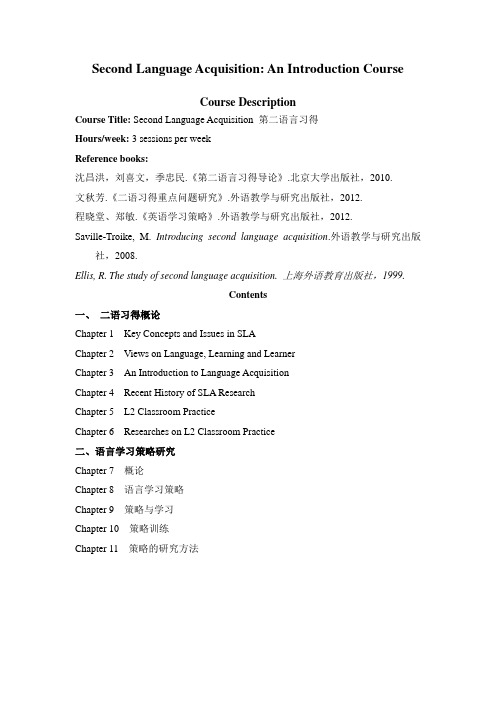
Second Language Acquisition: An Introduction CourseCourse DescriptionCourse Title: Second Language Acquisition 第二语言习得Hours/week: 3 sessions per weekReference books:沈昌洪,刘喜文,季忠民.《第二语言习得导论》.北京大学出版社,2010.文秋芳.《二语习得重点问题研究》.外语教学与研究出版社,2012.程晓堂、郑敏.《英语学习策略》.外语教学与研究出版社,2012.Saville-Troike, M. Introducing second language acquisition.外语教学与研究出版社,2008.Ellis, R. The study of second language acquisition. 上海外语教育出版社,1999.Contents一、二语习得概论Chapter 1 Key Concepts and Issues in SLAChapter 2 Views on Language, Learning and LearnerChapter 3 An Introduction to Language AcquisitionChapter 4 Recent History of SLA ResearchChapter 5 L2 Classroom PracticeChapter 6 Researches on L2 Classroom Practice二、语言学习策略研究Chapter 7 概论Chapter 8 语言学习策略Chapter 9 策略与学习Chapter 10 策略训练Chapter 11 策略的研究方法Chapter 1 Key Concepts and Issues in SLA1.1 Language Acquisition and SLAThe acquisition of language “is doubtless the greatest intellectual feat any one of us is ever required to perform.”--- Bloomfield, 1933A very young child began acquiring at least one language –what linguistists called as her First Language (L1) – mostly with very little conscious effort or awareness. L1 acquisition is a complicated but relatively rapid process through which a child grows up as a competent and proficient user of her native language(s). Every aspect of language acquisition is extremely complex. Yet young children – before the age of five – already know most of the intricate system which people have been naturally describing as the grammar of a language. Before they can add 2 plus 2, children are conjoining sentences, asking questions, using appropriate pronouns, negating sentences, forming relative clauses, and using the syntactic, phonological, morphological, and semantic rules of the grammar.Second language acquisition stands in contrast to first language acquisition. It is the study of how learners learn an additional language after they have acquired their mother tongue. The process of learning a non-native language is far more difficult, time-consuming, and much less likely to end in a state of complete mastery exactly fluency.SLA research has tended to follow in the footsteps of L1 acquisition research, both in its methodology and in many of the issues that it has treated. It is not surprising that a key issue has been the extent to which SLA and L1 acquisition are similar or different processes.1.2 A Theoretical Approach Proposed by SpolskyAn example of a particular theory or “model” of L2A from Spolsky is shown below:A “model” of L2A adapted from Spolsky (1989:28)This model depicts a “general theory of second language learning.” It depicts the researcher‟s theoretical views on the overall relationship between contextual factors, learner differences of individuals, learning opportunities and learning outcomes. The rectangular boxes show the factors that are most significant for learning. Any variation can lead to differences in success or failure. The arrows connecting the various boxes show the directions of influences. The contents of the various boxes are defined at great length, as consisting of clusters of interacting “Conditions”, making language learning successful.1.3 Some Distinctions in the field of SLA Research1.3.1 SLA and FLASLA is the study of L2A. According to the traditional definition, L2A typically takes place in a setting in which the language to be learned by a nonnative speaker is the language spoken in the local community. Therefore, a Chinese native learning English in England is generally defined as a L2 learner. In some definition L2A needs to take place in either an instructed setting or a non-instructed one.Foreign Language Acquisition (FLA) take place in a setting in which the language to be learned is not the one used in the local community. So the learning of English at schools in China would be an example of FLA. In most cases, FLA takes place in a setting with formal language instruction.Generally, the term SLA here is employed for referring to the study on both L2A and FLA because it is assumed that the underlying process is essentially similar.1.3.2 Acquisition versus LearningThe second tricky but also controversial distinction is the one between Acquisition and Learning. Krashen and Terrell (1983) define “acquisition”as the product of a “subconscious”process, similar to that of children in learning their L1, and learning as the product of formal teaching, which results in conscious knowledge about the language, but the distinction cannot be as simple as that.Krashen claimed that learning the rules could not lead to an automatic use of language as in acquisition. Probably, Krashen used the term “subconscious”in a non-technical sense, as the inability to explain what one knows. In other words, learners may use language forms correctly without being able to explain the forms.Accordingly, acquisition is seen as a natural process of growth of knowledge and skill in a language without a level of meta-knowledge about the language, while learning is seen as an artificial process in which the “rules” of a language are learned. There are indeed two differentmental process involved in acquisition and learning, but this does not mean that acquisition and learning cannot interact. Though not all learning necessarily leads to acquisition, learning could be the carrying out of activities that enhance the growth of knowledge.1.3.3 Input versus IntakeRelated to the notion of “consciousness” is the third distinction between Input and Intake. Input is everything around us we may perceive with our senses, and Intake (or Uptake) is what we pay attention to and notice.Some level of attention is required to be able to notice something, and that noticing is crucial for taking in new information. There is a lot of information in our environment, but what and how we make use of all that information depends on our needs and interests. (Most people may not be interested in the noise from the running machines, but for those who study on noise pollution it may get to be a very relevant piece of information. And at that point, they will notice. The same is true for language learning.) There is little doubt that input is the main source of information for learning, but not all input leads to intake, which is necessary for teaching. It is not easy to know under what condition input is actually helpful for learning. From experiments in consciousness, experts do know that unexpected events often arouse some attention.In addition, expectations are important for one‟s perceptibility and noticeability so it is clear that teaching may have an awareness-raising effect, increasing the noticing of features in input through the establishment of expectation and comprehension.For intake, at least some minimal level of mental processing needs to take place. There must be some awareness of new information relevant for the learning system to incorporate. Intake may refer to information that strengthens existing knowledge, or it may fill a gap in knowledge that was noticed by the learner before.1.3.4 Implicit versus Explicit LearningSchmidt (1990) points out that implicit learning is acquisition of knowledge about the underlying structure by a process that takes place naturally, simply and without conscious operations. Explicit learning is a more conscious operation where a learner makes and tests hypotheses in a search for structure.According to Schmidt, there is evidence that giving learners explicit rules helped in an experimental study, and the results of larger scale studies also slightly favor an explicit focus on grammar. But there is not much evidence on which to base an evaluation of the implicit rule acquisition in L2 learning. The implicit learning issue is the most difficult to resolve. On the one hand, there is evidence for it, but there is also evidence that conscious understanding helps in the process of L2A.Chapter 2 Views on Language, Learning and Learner2.1 Views on the Nature of LanguageAny human being is to acquire a language in the first few years of life. The knowledge acquired is largely of an unconscious sort. A school child could utter a fully formed sentence, which includes a relative clause (“I want that toy that that boy is playing with.”), not knowing how to state out the function of relative clauses and how to easily divide this sentence into its component parts.The complex knowledge humans have about their native languages is largely unconscious. There are several aspects of language to be described systematically.2.1.1 Phonetics and PhonologyThe sound system (phonology) of all languages is complex. Minimally, it entails knowing what possible sounds are and what are not for its native speakers.If a particular sound is studied on, it gets to the area of phonetics which describes the articulation of individual sounds. A native speaker of English can tell that the sound [x] in [Xi Hu] (the West Lake) is not a sound in English. The similar example can be the English consonants of [θ] & [ð] to speakers of other languages.Phonological knowledge also involves knowing what happens to words in fast speech as opposed to more carefully articulated speech. Consider the following dialogue between A (a nonnative speak) and B (a native speaker):A: What are you going to do?B: I’m gonna wriDa leDer.A: What? I can’t hear you.B: I’m going to write a letter (articulated slowly and clearly).Native speakers of a language know when to combine sounds in “normal, fast” speech and when not to in slower and clearer speech. They know not only possible sounds, but also know what are possible combinations of sounds and what sounds are found in what parts of words. In English, while [b] and [n] are both sounds of English, they cannot form a “blend” in the way that [b] and [r] can: *bnick versus brain. The sound [ŋ], which is frequent in English, however, cannot appear in the beginning of words in English, although it can in other languages.2.1.2 SyntaxThe syntax of a language is frequently known as its grammar, referring primarily to the knowledge of word order in a sentence. There are two kinds of grammar, generally referring to Prescriptive Grammar and Descriptive Grammar.Here are some prescriptive rules of English grammar as1) never end a sentence with a preposition;2) never split infinitives;3) never begin a sentence with a conjunction;4) never use contractions in writing;5) use between only with two items and among only with more than two.It is about such rules generally taught in school, often ignoring the actual use of the language.Modern linguists are concerned with descriptive grammars: the language as they are actually used. Thus, the knowledge of syntax just refers to descriptive grammar because native speakers of English frequently violate the prescriptive rules. As with phonological knowledge, native speakers of a language know which possible sentences of their language are.a. sentence ordere.g. The big book is on the brown table. (*The book big brown table the on is.)b. sentences with equivalent meaninge.g. Tom was hit by a car. (= A car hit Tom.)Yesterday Sally saw Jane. (Sally saw Jane yesterday.)Thus, knowing a language entails knowing a set of rules with which we can produce an infinite set of sentences.e.g. The woman wearing the green scarf ran across the street to see the gorilla that had justescaped from the zoo. (Even though such event is quite rare, people can understandwhat it really means.)2.1.3 MorphologyMorphology is the study of word formation. For example, the word reusable is made up of three parts: 1) re-, a prefix; 2) use, a verb; 3) –able, a suffix. Each part is referred to as a morpheme defined as the minimal unit of meaning. There are two classes of morphemes: bound and free. The former is one that can never be a word by itself; a free morpheme is one that is a word in and of itself.2.1.4 SemanticsSemantics refers to the study of meaning. It does not necessarily correspond to grammaticality because many ungrammatical sentences are meaningful as the following sentencese.g. *That woman beautiful is my mother.*I‟ll happy if I can get your paper.These sentences by nonnative speakers of English are comprehensible, though not following the “rules” of English. The opposite is the sentence that is grammatically formed but, because of the content, is meaningless (at least without additional contextualization), as in “*That bachelor ismarried.”Semantics entails knowledge of the reference of words. E.g. The English word table refers to an object with a flat top and either three or four legs.2.1.5 PragmaticsAnother area of language as what L2 learners need to learn has to do with pragmatics, or the use of language in context. For example, when we answer the telephone and someone says “Is John there?” We know that this is a request to speak with John. It would be strange to respond “Yes.” With the caller saying “Thank you.” and then hanging up. Clearly, the phrase “Is X there?”in this context is a request to speak with someone and not an information question. Similarly, the word order within a sentence may have an effect on meaning in some grammatical contexts.e.g. The man bit the dog. / The dog bit the man.2.2 Views of the Language Learning Process – L1versus L2The acquisition pattern is familiar: cries evolve to babbles, babbles are shaped into words, and words are joined to create sentences. This sequence describes the path taken by all children as the language they hear around them is taken in, internalized, and eventually developed into native-speaker competence.Experts try to understand how a child learns one language in a relatively simple cognitive and social environment, so that they have a basis for describing and interpreting a child‟s experience with multiple languages in complex social circumstances. The study of language acquisition began by carefully observing young children‟s learning to talk. Before there was a single hypothesis probing the nature of this process, researchers were recording the speech of their children and creating a database.In spite of agreement among researchers that the data are essential for theory building, reliable observations based on large numbers of children have been quite difficult. The studies tend, by necessity, to be small-scale, inferential, and complicated. But even the case study of a single child, presents a difficult task to the researcher. Documenting children‟s utterances in the compilation of a language diary requires great efforts, but those who have persisted have gained a wealth of insights.The challenge of empirical studies is to create indirect means of questioning, since researchers could not ask children directly to comment upon their linguistic reflections. Researchers could access children‟s language only through the filter of their cognition, and the two may not be equally developed.2.2.1 Children’s Acquisition of LexiconChildren‟s vocabulary acquisition needs to be described in three aspects of development: itsrate and pattern, the way words are used (or even misused), and the relation between lexicon and the child‟s cognitive development. The normative study in 1995 reported that by sixteen months of age children could reliably understand a mean of 191 words and produce a mean of 64 words. After that point, there is the legendary production speed: by thirty months of age, the mean number of words in productive vocabulary is 534.This period of rapid vocabulary growth during the second year of life has been called the “vocabulary burst”. However, even allowing for individual variation within the pattern, the rate of vocabulary growth throughout childhood is quite astonishing. Anglin in 1993 placed this progress at about 5 words per day during the school years; Clark in 1995 estimated the rate to be 10 words per day until the age of six and only slightly fewer through to the age of seventeen; in the boldest proposal of all, Pinker in 1995 declared that children learn one word every two waking hours from about eighteen months old through adolescence.A second salient aspect of children‟s early vocabulary is that early words are not always used correctly. Children make consistent, classifiable errors in their efforts to use their fledgling vocabularies. Children typically commit four types of errors while using words: overextension, underextension, overlap, and mismatch, but the greatest research attention has focused on overextension. The concepts to which words had been overextended usually shared some perceptual or functional feature with the actual meaning of the word, and children were attempting to label an unknown concept with a known word on the basis of analogy.2.2.2 Children’s Acquisition of SyntaxFrom the time children begin combining words to create compositional utterances, an achievement that begins to reveal itself at about eighteen months of age, there is an unmistakable respect for the word order demanded by the grammar of the adult language. More impressively, infants in the first year are able to distinguish between meanings of reversible sentences using only word order as a clue.Two aspects of syntactic development are noteworthy for general discussions of language acquisition and relevant to the extensions of these explanations into L2 acquisition. The first is the order in which the morphological system is mastered and the second is the overextension of syntactic rules.A. About the order of syntactic acquisitionOne of the striking discoveries in the study of language acquisition by Brown and his collaborators was that there was a relatively fixed order in which fourteen grammatical morphemes [such as plural (-s), progressive (-ing), and articles] were acquired into the productive competence of the children they studied. Documenting mastery of specific linguistic units isprecarious because children‟s early speech is so variable. Brown‟s decision in 1973 was to base judgments of acquisition on the criterion that children used a specific form in 90 percent of the obligatory contexts.Comparing different criteria for determining the point of acquisition, Bates, Bretherton, and Snyder in 1988 confirmed the stability of the order of acquisition of seven of the original fourteen morphemes across a group of children. This regularity in the order of acquisition of grammatical markers is a crucial fact of language acquisition that needs to be addressed by any theory.B. Time issue of children‟s early syntaxA second characteristic of children‟s early syntax is the existence of a period of time, usually beginning in the third year, in which they overextend grammatical rules to irregular forms.The preeminent example of this is the overuse of –ed to indicate past tense on irregular verbs, creating such forms as *goed instead of went. But it leads to a further question: Why do children universally and reliably commit such errors?2.2.3 Children’s Acquisition of PhonologyPhonology is the only aspect of language that is clear evident from the infant‟s first moments of life. The newborn baby reveals virtually nothing of the particular potential that will be shaped into the ability to use structured rules of order to express intentions and concepts in socially regulated ways; the ability to vocalize these ideas, however, is manifest. Recognizable speech is, of course, “a far cry” from the infant‟s first vocal outbursts, but the natural reliance on this channel of communication is evident. Equally, children born without the ability to hear begin life with hand gestures that are structurally and functionally equivalent to the vocal babbles of hearing children.A. The order in children‟s developing phonological abilitiesThe evolution of the infant‟s first cries into comprehensible speech undergoes several important stages:a. the first linguistic sounds are discriminated at about one month old;b. babbling begins at about seven months of age;c. the first word appears by approximately twelve months and the next two or three years are spent refining the sounds and prosody to match the adult standards of the speech community.Three aspects of this development are important to be noted. The first is the way in which speech sounds are organized into phonemic categories; the second is the sequence of sounds incorporated into babbling and ultimately into speech; and the third is the nature of the errors observed in early speech production.There is a profound result: after only four weeks of life, there is evidence of a preparedness toorganize heard speech into linguistic categories.B. The pattern and sequence of soundsThe second issue in children‟s developing phonological abilities is the pattern and sequence of sounds over which children gain mastery. Although it is reasonable straightforward to trace the course of phonological development across the major stages of cooing, babbling, and speaking, the qualitative shape of children‟s vocalizations at each of these stages is highly variable.C. Difficulty with certain phonemesAs sounds turn into words, children consistently encounter difficulty with certain phonemes. Words take on a “baby talk”style because they lack phonemic specification and include many homonyms. Many of these errors are systematic and reflect the application of specific rules, such as devoice final consonants, substitute stops for fricatives, or reduce consonant clusters to single consonantsHence, these simplification processes are rules only in a restricted sense as their application is neither predictable nor assured. They many be better described as strategies adopted by children to solve problems at a moment in time. In this sense, they may share common ground with the strategies used by children to refer to objects and concepts beyond their lexical potential.2.2.4 Children’s Acquisition of Semantics and PragmaticsPragmatics is the study of language use for communication which however, includes much more than language. So any examination of the pragmatic aspects of language should be done beyond the scope of standard linguistic analysis. Communication begins well before language is evident and includes interaction that are clearly outside the child‟developing linguistic competence.The pragmatic dimensions include a range of linguistic and nonlinguistic properties that contribute to the human interaction. Some are mechanical, such as the device of turn-taking; some are social, such as mutual attention to a common topic; some are cognitive, such as the speaker‟s communicative intentions; some are cultural, such as rules of politeness; and some are linguistic, such as the use of cohesion and coherence to connect ideas.All these aspects of the pragmatic use of language are learned by children at the same time as they are learning the formal structure of language. Before children have mastered the formal aspects of language, however, they are capable of interacting in a conversational style and communicating their intensions. Thus, communication begins long before language is established.If language is one part of a larger communicative ability and grows naturally out of children‟s interactions, then the burden of explanation for language structure and acquisition must begin with infant‟s early interactions and experiences. Language exists for communication and must beexplained in those terms. Thus the function of language – communication – is primary and must be placed at the center of explanation.Conversely, if the communication that is prior to the acquisition of linguistic structure is rudimentary, incomplete, or unsystematic, and it is only with the onset of language that intentions can be expressed reliably and systematically, then the essential aspect of language is its form, or structure. In this case, the pragmatic functions of language originate from its formal structure, and communication is a consequence of an orderly formal system.2.3 Views of the Second Language LearnerSLA research generally deals with learners who embark on the learning of an additional language, at least some years after they have started to acquire their first language. The infant bilingual (i.e. child who is exposed to more than one language from birth and acquires them more or less simultaneously in the first few years of life) is not the subject of SLA.This learning may take place formally and systematically, in a classroom setting; or it may take place through informal social contact, through work, through migration or other social forces that bring speakers of different languages into contact and make communication a necessity. So, L2 learners may be children, or adults; they may be learning the target language formally in schooling, or “pick it up”in the playground or the workplace. They may be learning a highly localized language, helping them to become insiders in a local community; or the target language may be one of wider communication relevant to their region, giving access to economic and public life.It is possible to distinguish three main points of view among SLA researchers as far as the learner is concerned:1) the linguistic perspective, concerning with modeling language structures and processes within the mind;2) the social psychological perspective, concerning with modeling individual differences among learners, and their implications for eventual learning success;3) the socio-cultural perspective, concerning with learners as social beings and members of social groups and networks.2.3.1 The Learner as Language ProcessorLinguists and psycholinguists have typically been concerned primarily with analyzing and modeling the inner mental mechanisms available to the individual learners, for processing, learning and storing new language knowledge. As far as language learning in particular is concerned, their aim is to document and explain the developmental route along which learners undergo.Researchers are less concerned with the speed or rate of development, or indeed with the degree of ultimate second language success. Thus they tend to minimize or disregard social and contextual differences among learners; their aim is to document universal mental processes available to all normal human beings.However, there is some controversy among researchers in this psycholinguistic tradition on the question of age. Do child and adult L2 learners learn in essentially similar ways? Or, is there a critical age that divides younger and older learners, a moment when early learning mechanisms are replaced or at least supplemented by other compensatory ways of learning?2.3.2 Differences between Individual LearnersReal-life observation quickly tells us, however, that even if L2 learners can be shown to be following a common developmental route, they differ greatly in the degree of success that they achieve. Social psychologists have argued consistently that these differences in learning outcomes must be due to individual differences among learners, and many proposals have been made concerning the characteristics that supposedly cause these differences. In a two-part review, Gardner and MacIntyre in 1992 and 1993 divided what they saw as the most important learner traits into two groups: 1) the cognitive; 2) the affective.2.3.3 Cognitive FactorsThere are usually three cognitive factors in SLA research:1) Intelligence: there is clear evidence that L2 students who are above average on formal measures of intelligence or general academic attainment tend to do well in L2A, at least in formal classroom settings.2) Language aptitude: is there really such a thing as a “gift” for language learning, distinct from general intelligence, as folk wisdom often holds? The best known formal test of language aptitude was designed in the 1950s.This “Modern Language Aptitude Test”assesses a number of sub-skills believed to be prediction of L2A success: ①phonetic coding ability; grammatical sensitivity; memory abilities; inductive language learning ability. It seems that the scores on these tests do indeed correlate with an achievement in a second language.3) Language learning strategies: do more successful language learners set about the task in some distinctive way? Do they have some personal learning strategies? Much research has been done to describe and categorize the strategies used by learners at different levels, and to link strategy use to learning outcomes.It is clear that more proficient learners do indeed employ strategies that are different from those used by the less proficient. Whether the strategies cause the learning, or the learning itself。
《第二语言习得》PPT课件

4. 学习者语言偏误的解释
• 对学习者偏误的解释需要对偏误的来源进 行分析,通过分析来建立与第二语言习得 相关的过程。
• 因而,对学习者偏误产生的来源的分析, 是基于偏误产生的过程的分析。
• 通过过程的分析对作为产出结果的偏误进 行解释。基于过程的偏误分析和解释才有 意义。
5. 学习者语言偏误的评价
• 对比分析的两种版本:
• 强势版本:用对照分析方式来预测困难等 级的方法。
• 弱势版本:使用对照分析法来解释可以观 察的到困难。Oller和Ziahosseiny提出细微 差异(subtle differences)版的对照分析假说 理论:“不管在单一或多种语言系统间, 即使他们的差异极为渺小,终究还是会产 生困惑。”
• 事实上,在汉语学习中,学习者的许多困难以及 学习者所犯的许多错误都与汉语和母语之间文化 方面的差异有关。
从“偏误分析”到“中介语” 到“学习 者语言
• Corder (1967 ) “The significance of leaners’ errors”
• Selinker (1972)“Interlanguage
学习者的水平、母语背景、习得的环境 • (3)语料收集的方式: • 自然表达、面谈、诱导、实验;横向与纵向;
2. 学习者语言偏误的鉴别
• 问题之一: “偏误”和“失误”的鉴别问 题
• 鉴别困难的原因: • 把学习者“语言能力”看做是“单质”
(homogeneous)的,因而无法解释学习 者语言偏误中出现的“变异” 现象; • 问题之二:如何区分学习者的“显性偏误” 和“隐性偏误” 。
• 选择。由于不可能对有关的两种语言所有的方面 都进行比较,因此,必须对要比较的某些语言形 式做些选择。
第二语言习得研究概述PPT课件

-
21
语言能力与语言表达 (competence / performance)
• Competence: (in Transformational
Generative Grammar) a person’s
internalized grammar of a language. This
means a person’s ability to create and
understand sentences, including sentences
they have never heard before. It also
includes a person’s knowledge of what are
and what are not sentences of a particular
-
19ห้องสมุดไป่ตู้
自然的第二语言习得与有指导 的第二语言习得
• Naturalistic SLA: It may happen in natural settings, as when children acquire their mother tongue: no one teaches children any grammar rules, but by age five or six, they are said to be in good command of almost all the basics of their mother tongue.
-
16
第一语言习得与第二语言习得 的差异
• 习得方式的差异:母语习得者先口语后 书面语;二语习得者常口头语言和书面 语言同时起步,增加了学习难度。
《二语言习得》课件

学习动机的激发
培养对目标语言的兴趣,明确学习目 标,以及从语言学习中获得成就感。
兴趣的持续性
通过多样化的学习材料和活动,保持 学习者的兴趣和动力。
语言遗忘与干扰
遗忘现象
随着时间的推移,不经常使用的语言知识可能会被遗忘。定期复习和巩固是必要的。
语言间的干扰
在学习第二语言时,学习者可能受到母语的干扰,导致语言习得困难。对比分析母语和目标语言的差异,有助于 减少这种干扰。
任务型教学
通过完成具体任务来学习语言, 强调语言的实际运用和意义理解 。
二语言习得中的自主学习与合作学习
自主学习
学习者自主制定学习计划、选择学习资源,培养独立学习和 解决问题的能力。
合作学习
通过小组合作、同伴互助等方式来学习语言,培养合作精神 和团队能力。
PART 04
二语言习得的困难与挑战
学习动机与兴趣的保持
探讨不同学习者的学习风 格,如视觉型、听觉型等 ,以及如何根据学习风格 提供有效的教学策略。
认知因素
研究认知能力、记忆、注 意力等因素对二语言习得 的影响,以及如何提高这 些认知能力。
二语言习得的跨文化研究
文化适应
研究学习者在跨文化环境中如何 适应目标语言的文化,以及文化
适应对语言习得的影响。
文化认知
在线学习平台
借助互联网和移动设备,构建在线学习平台,提 供丰富的语言学习资源和学习工具。
3
虚拟现实与增强现实
利用VR/AR技术为学习者创造沉浸式语言学习环 境,提高语言学习的真实感和趣味性。
二语言习得中的个体差异研究
学习动机
研究个体在学习二语言时 的动机差异,以及如何激 发和维持学习动机。
学习风格
《二语言习得》课件

异:了解目标语言的文化背景和语言习惯 交际技巧:掌握有效的沟通技巧,如倾听、表达、肢体语言等 文化适应:尊重并适应目标文化的价值观和习俗 文化交流:积极参与文化交流活动,提高跨文化交际能力
自主学习策略
添加标题
定义与特点:自主学习策略是一种学习者自我管理、自我监控和自我评估的学习方式,具有主动性、 独立性和有效性的特点。
社会文化理论
定义:社会文化理论是一种研究语言习得过程中社会文化因素的理论
核心概念:中介、最近发展区、支架等
理论观点:强调语言习得过程中社会文化因素的重要性,认为语言是社会文化交流的工具,语言习得是在社会文 化环境中通过与他人互动而实现的
实践应用:支架式教学、合作学习等
交互理论
定义:交互理论 是一种二语言习 得理论,强调学 习者通过与目标 语言的母语者进 行交流互动来提 高语言能力。
添加标题
理论基础:自主学习策略的理论基础包括建构主义学习理论、人本主义学习理论等,强调学习者的 主体性和自主性。
添加标题
实施步骤:自主学习策略的实施步骤包括制定学习计划、选择学习资源、进行自我监控和评估等, 旨在提高学习者的学习效果和自主学习能力。
添加标题
优势与局限性:自主学习策略的优势在于能够激发学习者的学习兴趣和动力,提高学习者的自主学习能力和终身学习能力; 其局限性在于需要学习者具备一定的自我管理和自我监控能力,同时也需要教师提供必要的指导和支持。
精读:仔细阅读文章,理解细 节
略读:快速浏览文章,寻找特 定信息
查读:查找特定信息,理解文 章结构
写作技巧与方法
确定主题和目标受众
收集相关资料和信息
制定写作计划和提纲
注重语言表达和修辞 手法
反复修改和完善文稿
第二语言习得02-PPT_28

.
/ \ intended length of residence) /
语言习得
第二节社会距离
____
一、社会主导模式指第二语言学习者群体与目的语群 体的平 等程度,包括:
言习得
第二节社会距离
••第二语言学习者在政治、经济、文化、科技等方面的地位 优于 目的语群体,第二语言学习者将不愿意学习目的语, ..习得效果差。
竺
第二语言习得
北京语言大学
IIpHo6peTeHHe BToporo M3biKa ■
LJ1
肖二语言习得
却25 5含导
O _______________________________________________________
O
文化适模式内容之一 社会距离
第二节社会距离
官文化适应的核心内容
(social dominance) /
'••• integration strategies) .•:
封闭程度
(enclosure)
群体大小
(size)
广,文化相似性、上 congruence or similarity) 技.:
(attitude)
. 1
「打算居住的时间/>
L
. —... __ . —
系 (Schumann, 1978B: 34)
I
[第二节社会距离
陳“文化适应程度”是一个非常抽象的概念,
0 Schumann是通过
/ “心理距离” (psychological distance)
来分析和阐述文化适应程度。
语言习得
第二节社会距离
却236合导
社会距离是指第二语言学习群体和目的语群体之间的关系。
第二语言习得PPT课件

六、“语言能力”与“语言表达”
• “语言能力”(competence): • 反映交际双方语言知识的心理语法。 • 母语使用者对句子的合语法性的直觉判断所依据的隐性语言知
识。 • “语言表达”(performance): • 交际双方在语言的理解与生成过程中对其内在语法的运用。 • 区别:语言能力是关于语言的知识,语言表达是关于语言运用
第18页/共35页
第 要•• 一二三回、十第世节顾二纪语6第0言年二习代语得末研:言究习的发得端研究的发端与发展的简
• 1. Corder:《学习者偏误的意义》 • 2. Selinker:《中介语》 • 二、第二语言习得研究发展的途径 • 1. 50-60年代:理论初创 • 2. 70年代:理论大发展 • 3. 80年代中期至今:新兴研究领域与方法 • 三、汉语作为第二语言习得的研究 • 80年代、90年代和90年代后
• 描写(Description):对两个语音系统进行细 致描写。
• 选择(selection): 结合偏误找出困难语项。 • 比较(comparison):对选定语项进行分析对
比,寻找共同处与不同处。 • 预测(prediction):在对比基础上预测可能
出现的错误。 • 2、难度等级:根据相同与不同点难度上的差异
进行了分级。认为差异越大难度越大,其实也 不尽然。
第24页/共35页
四、对比分析的局限
对比分析在60年代盛行,在70年代衰落。 对比分析的局限性主要表现在: 1、心理学基础为行为心理学,其核心思想“刺激—反应”理论受到乔姆斯基的猛
烈抨击和批判。 2、结构主义语言学并没有为对比分析找到解决问题的出路。(有共同范畴与否) 3、将“差异”等同于“难度”是不符合逻辑的。 4、其他理论假设也受到来自实验研究和教学实践的挑战和质疑。
第二语言习得理论课件

具体步骤是:模仿——强化——重复——成 形。
影响行为形成的要素有三:模仿、 强化、扩展(类比)。
遵循六原则: 结果控制原则 对可观察现象的测量 邻近原则 反应强度原则 概括原则 连锁和定型原则
受其影响的教学法:听说法。
忽视了人的主观能动性、创造性。
过分强调语言学习之外在行为,忽视语 言学习的内在过程。这样使语言学习过 程机械化简单化,不利于对语言学习的 研究。
阶段1 阶段2 阶段3 阶段4 ……
母语
中介语
目的语
中介语的特点
可渗透性:中介语是非封闭的,是一个有待 充实完善的系统,并非“紧实”,可受来自 母语、目标语规则的渗透。
渐变性(动态性):学习者的中介语始终处 于变化发展当中,且朝着目标语方向发展。
化石性(僵化):指中介语某些项目的僵化 。
反复性(多变性):中介语不是直线型发展 的,而是曲折发展的,会反复、多变。
将“差异”、“难”、“错误”这些概念简单的画上 等号是不对的。
将语言看作是可以分割的结构的组合,语言习得是掌 握各种结构的积累过程:1+1=2+1=3+1=4+……忽视能 动性、创造性。1+具 有很大的局限性。
偏误分析
1967年科德(Corder)发表了《学习者言语错 误的重要意义》一文,从一个全新的角度来 看待学习者的错误及第二语言习得研究。
※我和丈夫、女儿在留老师楼租了一个房间。
※愤怒的老百姓在广州附近杀害了外国人。
※去中国的人都要去看看世界文明的万里长城 。
※我来中国以后,第一次经验北京的夏天。
※方便的时去自选商场,要求服务高级、商品 高级的时去百货商场。
二语习得ppt课件

25
一、语言输入与语言形式调整的研究
(一)“外国人话语”的特点
“外国人话语”——指外国人的话语?(×) ——指对外国人说的话语。
Ferguson:“外国人话语”是指说某语言的人对该 语言能力有限者或者根本没有该语言能力者所使用 的一种简化的语体。 “外国人话语”与标准英语有三方面不用:
26
“外国人话语”与标准英语有三方面不用: 1.语音方面:语速慢、发音清楚、停顿、重音、夸
Hatch and Wagner-Gough,1976 Hatch ,1978a Peck,1978
早期关注是学习者的语言产出 语言输入与互动
5
研究材料来自母语者与学习者交流的转写材料,这些 材料使研究者不仅能观察到学习者的语言产出过程, 即学习者是怎么说的,同时也可以观察到母语者为学 习者提供语言输入的过程,即母语者对学习者是怎样 说的。
• 另一方面,外在的语言输入为学习者提供的仅仅 是关于目的语结构规则的“正面证据”( positive evidence),缺少“反面证据”( negative evidence)。
• 结果: 知道“怎样说”,不知道那些规则“不能 说”。
41
对“儿向语言”的研究
• 有学者发现:儿童的父母或保姆为儿童提供的都是符合规 则的话语,几乎很少纠正儿童的语法错误,为儿童提供不 合规则的反面证据。
例:你是哪国人? 你,哪个国家的?
教师语言:对外汉语教学课堂 例:请大家打开书。 书Book,打开Open
8
第二语言习得发展的重要影响
1、母语者与第二语言学习者交流使用的话语具有的“外国 人话语”“教师语言”特点,这种特定的语域风格的话语 为第二语言学习者提供了一个可理解输入环境。
- 1、下载文档前请自行甄别文档内容的完整性,平台不提供额外的编辑、内容补充、找答案等附加服务。
- 2、"仅部分预览"的文档,不可在线预览部分如存在完整性等问题,可反馈申请退款(可完整预览的文档不适用该条件!)。
- 3、如文档侵犯您的权益,请联系客服反馈,我们会尽快为您处理(人工客服工作时间:9:00-18:30)。
2.3
Nature of Learning
Learning contains a number of characteristic features (Brown, 1994):
Unit 2 Reviewing Bases of Second Language Acquisition
Unit Preview
Unit topic focus: definition of language different views about language nature of learning misconceptions of learning mystery of first language acquisition
Learning contains a number of characteristic features (Brown, 1994):
1) Learning is acquisition or "getting". 2) Learning is retention of knowledge, information or skill. 3) Retention implies storage systems, memory, and cognitive organization. 4) Learning involves active, conscious focus on and acting upon events outside or inside the
Pre-learning Tasks
1. Search the internet to get the definitions of language and learning and explain them with examples to your classmates. 2. Reflect on your own experience of learning the mother tongue. 3. How do you understand the act of learning? Is language learning similar to other types of learning? Why ?
2.2
Different Views about Language
Views at the-turn-of-the-century
1) language is a system: each element of the language has a value only in terms of the rules under which it operates and in relation to all other elements.
2.2
Different Views about Language
The functionalists’view represented by M. A. K. Halliday 5) The interpersonal function allows a speaker to express feelings, emotions and personality. 6) The interpersonal function allows a speaker to express feelings, emotions and personality. 7) The imaginative function serves to create imaginary systems or ideas.
In short, language is a unique system of communication, and it is the cornerstone of society.
2.2
Different Views about Language
The primitive view
1) language is an organism: growth and change are of more interest than the static formal rules.
2) language is writing: the written record of the language is the “purest” form. Speech is secondary and to be distrusted since it is ephemeral and degenerate. 3) language is conventional: language is conventional and it is not only invented, but in its progressive advancement, it varies for the purposes of practical convenience.
2.1
What is Language?
"Language is a system of arbitrary vocal symbols used for human communication." (Wardhaugh 1977).
2.1
What is Language?
• By "system" we mean the recurring patterns or arrangements or the particular ways or designs in which a language operates. All elements in the system of language are arranged in accordance with certain rules; they can not be combined at will. • By “arbitrary vocal symbols” it is meant that anything that represents something else is a symbol, for example, the dove is the symbol of peace. Language consists of another type of symbols, s. These symbols are not chosen for any particular reasons but at random.
2) The regulatory function is the control of events.
3) The representational function is the use of language to “represent” reality as one sees it. 4) The interactional function serves to ensure social maintenance.
2.2
Different Views about Language
The mentalists’ view represented by N. Chomsky 1) language is a system which relates meaning to substance: it emphasizes meaning in linguistic description. 2) language is a mental phenomenon and innate: the innateness of language suggests a genetically imparted ability for language learning. 3) language is universal: all normal children acquire a mother tongue. At a highly abstract level, all languages must share some universal characteristics.
2.2
Different Views about Language
The functionalists’view represented by M. A. K. Halliday 1) The instrumental function serves to manipulate the environment.
2) language is a structural system: language is a system of forms, elements or items of which are combined in certain ways to create sentences. 3) language is an arbitrary system: there is absolutely no relationship between the words and the objects they represent.
2.3
Nature of Learning
Learning is "acquiring or getting of knowledge of a subject or a skill by study, experience, or instruction" ----Longman Dictionary of Contemporary English Learning is a relatively permanent change in a behavioral tendency and is the result of reinforced practice. ----Kimble & Garmezy, 1963
